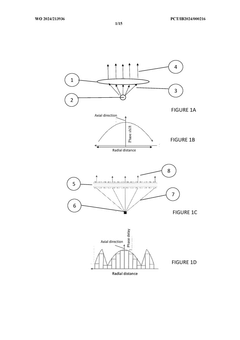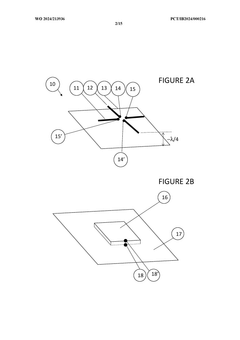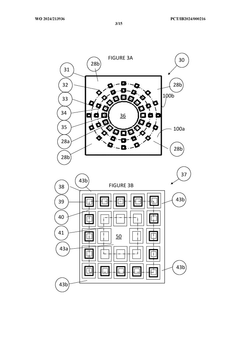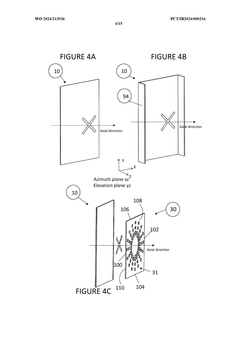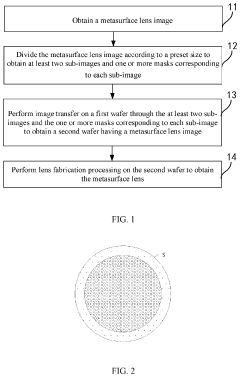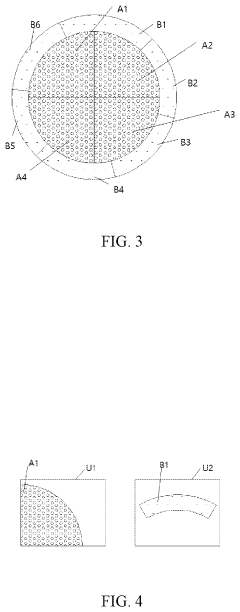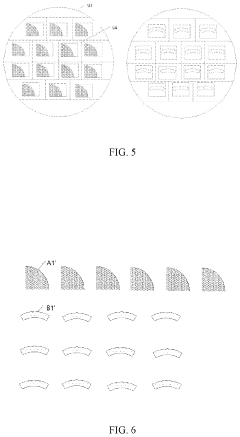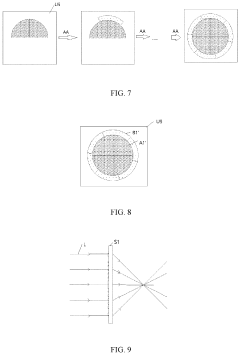Comparison of Metasurface Antennas with Lens-Based Systems
SEP 25, 20259 MIN READ
Generate Your Research Report Instantly with AI Agent
Patsnap Eureka helps you evaluate technical feasibility & market potential.
Metasurface Antenna Technology Evolution and Objectives
Metasurface antennas represent a revolutionary advancement in electromagnetic wave manipulation technology, emerging from the broader field of metamaterials research that gained significant momentum in the early 2000s. These ultra-thin, planar structures consist of subwavelength elements arranged in specific patterns to control electromagnetic wavefronts with unprecedented precision. The evolution of this technology can be traced back to frequency selective surfaces and reflectarrays, but metasurfaces have transcended these predecessors through their ability to manipulate phase, amplitude, and polarization simultaneously.
The development trajectory of metasurface antennas has been marked by several key milestones. Initially, research focused on passive metasurfaces with fixed functionalities. By 2010, researchers demonstrated basic beam-steering capabilities, followed by more sophisticated wavefront shaping. The period between 2015-2020 saw significant advancements in reconfigurable metasurfaces, incorporating active elements like PIN diodes, varactors, and MEMS to enable dynamic control of electromagnetic properties.
In parallel with metasurface development, lens-based antenna systems have undergone their own evolution. Traditional dielectric lenses have been used in antenna systems for decades, with Luneburg lenses and gradient-index (GRIN) lenses representing important innovations. More recently, 3D-printed lens technologies have expanded design possibilities while reducing manufacturing constraints.
The convergence of these technologies has created a rich landscape for comparison and potential integration. While lens-based systems offer mature technology with well-understood electromagnetic behavior, they typically suffer from bulk, weight, and limited flexibility. Metasurfaces, conversely, provide unprecedented thinness and design flexibility but face challenges in bandwidth, efficiency, and power handling.
The primary technical objectives in this field now center on overcoming these limitations through innovative approaches. Researchers aim to develop metasurface antennas with broader bandwidth capabilities, higher efficiency, and improved power handling characteristics. Another critical goal involves creating truly reconfigurable metasurfaces that can adapt their properties in real-time, potentially replacing multiple conventional antennas with a single adaptive surface.
Looking forward, the integration of metasurface principles with traditional lens technologies represents a promising direction. Hybrid systems combining the advantages of both approaches could potentially overcome the limitations of each individual technology. The ultimate objective remains the development of antenna systems that are simultaneously compact, efficient, broadband, and dynamically reconfigurable across multiple parameters.
The development trajectory of metasurface antennas has been marked by several key milestones. Initially, research focused on passive metasurfaces with fixed functionalities. By 2010, researchers demonstrated basic beam-steering capabilities, followed by more sophisticated wavefront shaping. The period between 2015-2020 saw significant advancements in reconfigurable metasurfaces, incorporating active elements like PIN diodes, varactors, and MEMS to enable dynamic control of electromagnetic properties.
In parallel with metasurface development, lens-based antenna systems have undergone their own evolution. Traditional dielectric lenses have been used in antenna systems for decades, with Luneburg lenses and gradient-index (GRIN) lenses representing important innovations. More recently, 3D-printed lens technologies have expanded design possibilities while reducing manufacturing constraints.
The convergence of these technologies has created a rich landscape for comparison and potential integration. While lens-based systems offer mature technology with well-understood electromagnetic behavior, they typically suffer from bulk, weight, and limited flexibility. Metasurfaces, conversely, provide unprecedented thinness and design flexibility but face challenges in bandwidth, efficiency, and power handling.
The primary technical objectives in this field now center on overcoming these limitations through innovative approaches. Researchers aim to develop metasurface antennas with broader bandwidth capabilities, higher efficiency, and improved power handling characteristics. Another critical goal involves creating truly reconfigurable metasurfaces that can adapt their properties in real-time, potentially replacing multiple conventional antennas with a single adaptive surface.
Looking forward, the integration of metasurface principles with traditional lens technologies represents a promising direction. Hybrid systems combining the advantages of both approaches could potentially overcome the limitations of each individual technology. The ultimate objective remains the development of antenna systems that are simultaneously compact, efficient, broadband, and dynamically reconfigurable across multiple parameters.
Market Applications and Demand Analysis
The metasurface antenna and lens-based system market is experiencing significant growth driven by the expanding telecommunications sector, particularly with the global rollout of 5G networks. The demand for high-performance, compact, and cost-effective antenna solutions has created a fertile ground for both technologies to flourish. Current market analysis indicates that the global antenna market is projected to reach $30 billion by 2025, with metasurface and advanced lens technologies representing increasingly important segments.
Telecommunications operators are actively seeking solutions that can provide high gain, wide bandwidth, and beam-steering capabilities while maintaining a low profile. This demand is particularly acute in urban environments where space constraints and aesthetic considerations limit the deployment of traditional bulky antenna systems. Metasurface antennas, with their ultra-thin profile and conformal capabilities, address these requirements effectively, driving their adoption in dense urban deployments.
The satellite communication sector represents another significant market driver. With the proliferation of satellite constellations for global internet coverage, such as Starlink and OneWeb, there is growing demand for ground terminals that are compact, efficient, and capable of electronic beam steering. Both metasurface antennas and lens-based systems are competing to capture this expanding market segment, with each offering distinct advantages in terms of cost, performance, and form factor.
Defense and aerospace applications constitute a premium market segment where performance often outweighs cost considerations. Radar systems, electronic warfare, and secure communications all require advanced antenna technologies. The demand for conformal antennas that can be integrated into aircraft skins or vehicle surfaces favors metasurface solutions, while high-gain requirements for long-range detection systems may favor lens-based approaches.
Emerging applications in autonomous vehicles and smart cities are creating new market opportunities. Advanced driver assistance systems (ADAS) require compact, high-performance radar and communication antennas, while smart city infrastructure demands unobtrusive sensing and communication capabilities. The market potential in these sectors is substantial, with automotive radar alone expected to grow at a CAGR of 21% through 2026.
Consumer electronics represents a volume-driven market where cost and size are critical factors. As AR/VR devices, wearables, and IoT devices proliferate, the demand for miniaturized, efficient antennas grows correspondingly. Metasurface technologies, with their potential for mass production using established semiconductor fabrication techniques, may hold an advantage in addressing this market segment compared to traditional lens-based systems.
Telecommunications operators are actively seeking solutions that can provide high gain, wide bandwidth, and beam-steering capabilities while maintaining a low profile. This demand is particularly acute in urban environments where space constraints and aesthetic considerations limit the deployment of traditional bulky antenna systems. Metasurface antennas, with their ultra-thin profile and conformal capabilities, address these requirements effectively, driving their adoption in dense urban deployments.
The satellite communication sector represents another significant market driver. With the proliferation of satellite constellations for global internet coverage, such as Starlink and OneWeb, there is growing demand for ground terminals that are compact, efficient, and capable of electronic beam steering. Both metasurface antennas and lens-based systems are competing to capture this expanding market segment, with each offering distinct advantages in terms of cost, performance, and form factor.
Defense and aerospace applications constitute a premium market segment where performance often outweighs cost considerations. Radar systems, electronic warfare, and secure communications all require advanced antenna technologies. The demand for conformal antennas that can be integrated into aircraft skins or vehicle surfaces favors metasurface solutions, while high-gain requirements for long-range detection systems may favor lens-based approaches.
Emerging applications in autonomous vehicles and smart cities are creating new market opportunities. Advanced driver assistance systems (ADAS) require compact, high-performance radar and communication antennas, while smart city infrastructure demands unobtrusive sensing and communication capabilities. The market potential in these sectors is substantial, with automotive radar alone expected to grow at a CAGR of 21% through 2026.
Consumer electronics represents a volume-driven market where cost and size are critical factors. As AR/VR devices, wearables, and IoT devices proliferate, the demand for miniaturized, efficient antennas grows correspondingly. Metasurface technologies, with their potential for mass production using established semiconductor fabrication techniques, may hold an advantage in addressing this market segment compared to traditional lens-based systems.
Current Capabilities and Technical Challenges
Metasurface antennas and lens-based systems represent two distinct approaches to electromagnetic wave manipulation, each with unique capabilities and limitations. Metasurface antennas, characterized by their sub-wavelength thickness and planar structure, have demonstrated remarkable beam-forming capabilities with high directivity and gain comparable to traditional antenna systems. Current implementations can achieve beam steering angles exceeding 60 degrees with minimal pattern degradation, and frequency bandwidths of up to 20% in advanced designs.
Lens-based systems, by contrast, leverage their three-dimensional structure to achieve exceptional focusing properties. Modern dielectric lens antennas can provide gains exceeding 30 dBi with aperture efficiencies approaching 80% in optimized configurations. Their inherent broadband nature allows operation across frequency ranges spanning multiple octaves without significant performance degradation.
Despite these achievements, both technologies face significant technical challenges. Metasurface antennas struggle with efficiency limitations, typically achieving only 60-70% efficiency due to inherent material losses and reflection issues. Their bandwidth constraints remain problematic for wideband applications, with performance degradation occurring outside their designed frequency range. Additionally, fabrication precision requirements increase substantially at higher frequencies, where nanometer-scale feature accuracy becomes critical.
Lens-based systems contend with different challenges, primarily related to their physical dimensions. Their bulky nature contradicts modern device miniaturization trends, creating integration difficulties in compact systems. Weight considerations become particularly problematic in mobile or aerospace applications. Furthermore, traditional lens systems suffer from aberrations that limit their performance, especially in wide-angle scanning scenarios.
Both technologies face common challenges in thermal management, particularly in high-power applications where material properties can degrade under elevated temperatures. Cost-effective manufacturing at scale remains elusive, with current production methods often requiring specialized equipment and processes that don't translate well to mass production environments.
Recent research has focused on hybrid approaches that combine elements of both technologies to mitigate their respective limitations. These include gradient-index metasurfaces that mimic lens behavior while maintaining a relatively flat profile, and integrated lens-metasurface systems that leverage the strengths of both paradigms.
The development of novel materials with enhanced electromagnetic properties represents another frontier, with researchers exploring engineered composites and metamaterials that could potentially overcome current efficiency and bandwidth limitations while enabling more compact designs.
Lens-based systems, by contrast, leverage their three-dimensional structure to achieve exceptional focusing properties. Modern dielectric lens antennas can provide gains exceeding 30 dBi with aperture efficiencies approaching 80% in optimized configurations. Their inherent broadband nature allows operation across frequency ranges spanning multiple octaves without significant performance degradation.
Despite these achievements, both technologies face significant technical challenges. Metasurface antennas struggle with efficiency limitations, typically achieving only 60-70% efficiency due to inherent material losses and reflection issues. Their bandwidth constraints remain problematic for wideband applications, with performance degradation occurring outside their designed frequency range. Additionally, fabrication precision requirements increase substantially at higher frequencies, where nanometer-scale feature accuracy becomes critical.
Lens-based systems contend with different challenges, primarily related to their physical dimensions. Their bulky nature contradicts modern device miniaturization trends, creating integration difficulties in compact systems. Weight considerations become particularly problematic in mobile or aerospace applications. Furthermore, traditional lens systems suffer from aberrations that limit their performance, especially in wide-angle scanning scenarios.
Both technologies face common challenges in thermal management, particularly in high-power applications where material properties can degrade under elevated temperatures. Cost-effective manufacturing at scale remains elusive, with current production methods often requiring specialized equipment and processes that don't translate well to mass production environments.
Recent research has focused on hybrid approaches that combine elements of both technologies to mitigate their respective limitations. These include gradient-index metasurfaces that mimic lens behavior while maintaining a relatively flat profile, and integrated lens-metasurface systems that leverage the strengths of both paradigms.
The development of novel materials with enhanced electromagnetic properties represents another frontier, with researchers exploring engineered composites and metamaterials that could potentially overcome current efficiency and bandwidth limitations while enabling more compact designs.
Comparative Analysis of Existing Solutions
01 Performance comparison of metasurface antennas vs traditional antennas
Metasurface antennas offer superior performance compared to traditional antennas in terms of beam steering capabilities, bandwidth, and efficiency. These antennas utilize engineered surfaces with sub-wavelength structures to manipulate electromagnetic waves, resulting in enhanced gain, reduced side lobes, and improved radiation patterns. Performance metrics show metasurface antennas can achieve wider scanning angles and maintain performance across broader frequency ranges while having a more compact form factor.- Performance comparison of metasurface antennas versus conventional antennas: Metasurface antennas offer significant advantages over conventional antennas in terms of size, weight, and performance. These antennas utilize engineered surfaces with sub-wavelength structures to manipulate electromagnetic waves, resulting in improved gain, bandwidth, and radiation efficiency. Performance comparisons show that metasurface antennas can achieve higher directivity while maintaining a lower profile than traditional antenna designs, making them suitable for space-constrained applications.
- Metasurface lens systems for beam focusing and steering: Metasurface lens-based systems provide advanced beam focusing and steering capabilities through the manipulation of electromagnetic wavefronts. These systems use arrays of sub-wavelength resonators to control phase, amplitude, and polarization of incident waves with high precision. Compared to conventional optical lenses, metasurface lenses offer reduced thickness, weight, and form factor while achieving comparable or superior focusing performance. They enable dynamic beam steering without mechanical movement, which is particularly valuable for radar and communication applications.
- Frequency response and bandwidth comparison between metasurface and traditional systems: Analysis of frequency response characteristics shows that metasurface-based antenna and lens systems can achieve broader bandwidth operation compared to conventional systems. Metasurfaces can be designed with multi-resonant structures that maintain performance across wider frequency ranges. Studies demonstrate that properly designed metasurface antennas can operate effectively across multiple bands while maintaining stable radiation patterns and impedance matching. This multi-band capability represents a significant advantage over traditional single-band antenna designs, particularly for modern communication systems requiring operation across diverse frequency ranges.
- Efficiency and power handling capabilities of metasurface systems: Comparative analysis of efficiency metrics reveals that metasurface antennas and lens systems can achieve high radiation efficiency while maintaining excellent power handling capabilities. The engineered electromagnetic properties of metasurfaces allow for optimized energy conversion and reduced losses compared to conventional systems. Advanced metasurface designs incorporate materials and structures specifically engineered to minimize absorption losses and maximize radiation efficiency. These improvements result in systems that can handle higher power levels while maintaining thermal stability, making them suitable for high-power transmission applications.
- Integration advantages of metasurface technology in communication systems: Metasurface antennas and lens-based systems offer significant integration advantages in modern communication platforms compared to conventional technologies. Their planar profile and reduced form factor enable seamless integration into existing systems with minimal spatial requirements. Performance evaluations demonstrate that integrated metasurface solutions can achieve comparable or superior signal quality while reducing overall system complexity. The ability to conform to various surfaces makes metasurface technology particularly valuable for applications where space constraints are critical, such as in satellite communications, mobile devices, and automotive radar systems.
02 Lens-based systems for beam focusing and directivity enhancement
Lens-based systems employ dielectric or metamaterial lenses to focus electromagnetic waves, enhancing directivity and gain in antenna systems. These systems can transform spherical wavefronts into planar ones, improving signal quality and reducing interference. Performance evaluations demonstrate that lens-based systems provide significant improvements in focusing capability, especially at millimeter-wave and terahertz frequencies, while offering advantages in terms of manufacturing simplicity compared to complex metasurface designs.Expand Specific Solutions03 Integration of metasurfaces in 5G/6G communication systems
Metasurface antennas and lens-based systems show promising performance for next-generation wireless communication networks. In 5G and 6G applications, these technologies enable massive MIMO implementations, beamforming capabilities, and efficient spectrum utilization. Comparative analysis reveals that metasurface-enabled systems can achieve higher data rates, lower latency, and better coverage in dense urban environments while consuming less power than conventional antenna arrays, making them ideal for future communication infrastructure.Expand Specific Solutions04 Reconfigurable metasurfaces for adaptive beam control
Reconfigurable metasurfaces provide dynamic control over electromagnetic wave propagation, allowing real-time adjustment of beam direction, polarization, and focusing properties. These systems incorporate active elements such as PIN diodes, varactors, or MEMS switches to modify surface impedance characteristics on demand. Performance evaluations demonstrate superior adaptability compared to fixed lens systems, with reconfigurable metasurfaces showing exceptional capabilities in tracking moving targets, mitigating interference, and optimizing signal quality across changing environmental conditions.Expand Specific Solutions05 Fabrication techniques and cost-performance analysis
The manufacturing processes and associated costs significantly impact the performance-to-price ratio of metasurface antennas versus lens-based systems. While metasurfaces often require more precise fabrication techniques like photolithography or nanoimprinting, lens-based systems can be manufactured using more conventional methods. Comparative analysis shows that although metasurfaces may have higher initial production costs, their superior performance, miniaturization capabilities, and potential for mass production can provide better long-term value, especially in applications requiring high precision and compact form factors.Expand Specific Solutions
Leading Companies and Research Institutions
The metasurface antenna market is currently in a growth phase, transitioning from research to commercialization with an estimated market size of $1.2-1.5 billion by 2027. Compared to traditional lens-based systems, metasurface technology offers significant miniaturization and integration advantages. Leading players include Kuang-Chi and Kymeta in commercial applications, while Metalenz has pioneered semiconductor-compatible meta-optics. Research powerhouses like Tsinghua University, KAIST, and Boston University are advancing fundamental technologies. Major corporations including Huawei, Samsung, and Intel are investing heavily in metasurface R&D, particularly for 5G/6G communications, automotive radar, and consumer electronics applications, indicating the technology's growing maturity and strategic importance across multiple industries.
Kuang-Chi Innovative Technology Ltd.
Technical Solution: Kuang-Chi has developed advanced metamaterial-based antenna systems that leverage their proprietary "Super Material" technology. Their metasurface antennas utilize artificially engineered electromagnetic structures with subwavelength features arranged in precise patterns to manipulate wavefronts with unprecedented control. Unlike conventional lens-based systems that rely on curved surfaces and refractive properties, Kuang-Chi's metasurface approach achieves similar or superior beam-forming capabilities through planar structures typically less than 5mm thick. The company has implemented gradient-index metasurfaces that can achieve precise phase control across the antenna aperture, enabling high-gain, directional beam patterns without the bulk of traditional lens systems. Their technology incorporates active elements that allow for dynamic beam steering without mechanical movement, achieving scanning angles of up to ±60° with minimal performance degradation. Kuang-Chi has demonstrated particular success in 5G mmWave applications, where their metasurface antennas have shown 30-40% size reduction compared to lens-based alternatives while maintaining comparable gain performance of approximately 25-30 dBi.
Strengths: Extremely thin profile compared to lens systems; elimination of mechanical components for beam steering; reduced manufacturing complexity; excellent performance in mmWave frequencies. Weaknesses: Higher design complexity requiring sophisticated electromagnetic modeling; potential challenges in extremely wideband applications; temperature sensitivity that may require compensation mechanisms; higher computational requirements for controlling active elements.
Kymeta Corp.
Technical Solution: Kymeta has developed a groundbreaking metasurface antenna technology specifically targeting satellite communications. Their mTenna platform utilizes liquid crystal-based metasurfaces that can be electronically tuned to dynamically steer beams without mechanical components. The technology employs a holographic approach where the metasurface is configured to create constructive and destructive interference patterns that form and direct beams toward satellites. Kymeta's u8 terminal, their flagship product, incorporates this technology in a low-profile form factor that's approximately 20-30 times thinner than comparable parabolic dishes. The metasurface consists of thousands of tunable elements that can be individually controlled to modify the electromagnetic properties of the surface, enabling beam steering across a wide field of view. Unlike traditional lens-based systems that require physical movement for tracking, Kymeta's solution achieves this electronically, significantly improving reliability while reducing power consumption by approximately 65%. The technology operates effectively in Ku-band frequencies and has demonstrated data rates exceeding 90 Mbps in field deployments.
Strengths: Electronic beam steering eliminates mechanical failures; low profile design (less than 10 cm thick); reduced power consumption compared to motorized systems; software-defined operation allowing for flexible service provider switching. Weaknesses: Higher initial cost compared to traditional parabolic antennas; performance limitations in extreme weather conditions; requires specialized control software; bandwidth constraints compared to some larger fixed antenna systems.
Key Patents and Scientific Breakthroughs
Application of a metasurface lens
PatentWO2024213936A1
Innovation
- A metasurface lens is integrated with a radiating element, featuring a dielectric substrate with conductive scattering elements that apply phase shifts to electromagnetic waves, optimizing wavefront curvature and reducing back-scattered energy to mitigate impedance issues and enhance antenna performance.
Method for fabricating metasurface lens and metasurface lens
PatentPendingUS20240053513A1
Innovation
- A method involving dividing the metasurface lens image into sub-images and using corresponding masks for image transfer on a wafer, followed by lens fabrication, which includes active alignment to optimize modulation transfer function and splicing, thereby improving efficiency and reducing costs.
Manufacturing Processes and Cost Considerations
Manufacturing processes for metasurface antennas and lens-based systems represent a critical factor in their commercial viability and widespread adoption. Metasurface antennas typically employ planar fabrication techniques derived from the semiconductor industry, including photolithography, electron beam lithography, and nanoimprint lithography. These processes enable precise patterning of sub-wavelength elements on substrate materials such as silicon, glass, or flexible polymers. The planar nature of metasurfaces allows for compatibility with standard PCB manufacturing infrastructure, potentially enabling mass production at lower unit costs when scaled appropriately.
In contrast, lens-based systems rely on more traditional manufacturing methods including precision grinding, polishing, and molding of dielectric materials. These processes are well-established but often require specialized equipment and skilled labor, particularly for high-frequency applications where surface accuracy becomes increasingly critical. The three-dimensional nature of lens components introduces additional complexity in terms of assembly and alignment tolerances, which can significantly impact production yields and costs.
Cost considerations reveal notable differences between these technologies. Metasurface antennas typically have higher initial development and tooling costs due to the precision requirements of nanofabrication processes. However, they offer potential advantages in terms of material efficiency, with most designs requiring only thin layers of conductive materials on relatively inexpensive substrates. The planar form factor also reduces packaging and integration costs in many applications, particularly for conformal installations where traditional lenses would be impractical.
Lens-based systems generally have lower development costs but higher per-unit material expenses, especially when using specialized dielectric materials with specific electromagnetic properties. The weight and volume of lens components also increase shipping and handling costs compared to the more compact metasurface alternatives. However, lens manufacturing benefits from decades of process optimization and established supply chains, which can provide cost advantages for certain applications and production volumes.
Recent advancements in additive manufacturing technologies are beginning to impact both approaches. 3D printing of gradient-index lenses and metamaterial structures offers new possibilities for cost-effective prototyping and customization. Similarly, roll-to-roll fabrication techniques are emerging as promising methods for large-scale, low-cost production of metasurfaces, potentially addressing one of the key barriers to widespread commercial adoption.
In contrast, lens-based systems rely on more traditional manufacturing methods including precision grinding, polishing, and molding of dielectric materials. These processes are well-established but often require specialized equipment and skilled labor, particularly for high-frequency applications where surface accuracy becomes increasingly critical. The three-dimensional nature of lens components introduces additional complexity in terms of assembly and alignment tolerances, which can significantly impact production yields and costs.
Cost considerations reveal notable differences between these technologies. Metasurface antennas typically have higher initial development and tooling costs due to the precision requirements of nanofabrication processes. However, they offer potential advantages in terms of material efficiency, with most designs requiring only thin layers of conductive materials on relatively inexpensive substrates. The planar form factor also reduces packaging and integration costs in many applications, particularly for conformal installations where traditional lenses would be impractical.
Lens-based systems generally have lower development costs but higher per-unit material expenses, especially when using specialized dielectric materials with specific electromagnetic properties. The weight and volume of lens components also increase shipping and handling costs compared to the more compact metasurface alternatives. However, lens manufacturing benefits from decades of process optimization and established supply chains, which can provide cost advantages for certain applications and production volumes.
Recent advancements in additive manufacturing technologies are beginning to impact both approaches. 3D printing of gradient-index lenses and metamaterial structures offers new possibilities for cost-effective prototyping and customization. Similarly, roll-to-roll fabrication techniques are emerging as promising methods for large-scale, low-cost production of metasurfaces, potentially addressing one of the key barriers to widespread commercial adoption.
Integration Strategies for Communication Systems
The integration of metasurface antennas and lens-based systems into modern communication infrastructure requires careful consideration of various architectural approaches and implementation methodologies. When examining integration strategies, system designers must evaluate the physical form factor constraints that differ significantly between these technologies. Metasurface antennas typically offer a more compact and planar profile, facilitating seamless integration into space-constrained devices and conforming to non-planar surfaces, while lens-based systems often require more substantial spatial accommodation due to their three-dimensional structure.
Power consumption represents another critical integration consideration. Metasurface antennas with active elements may require sophisticated power distribution networks and control circuitry, whereas traditional lens systems generally exhibit passive operation with minimal power requirements. This distinction significantly impacts the design of power subsystems and thermal management strategies within the broader communication platform.
Signal processing requirements also diverge substantially between these technologies. Metasurface implementations frequently demand complex digital control systems to manage phase manipulation across numerous elements, necessitating integration with dedicated processing units. Conversely, lens-based systems typically rely on more straightforward signal chains, potentially simplifying the overall system architecture and reducing computational overhead.
Manufacturing and assembly processes present distinct integration challenges. Metasurface antennas leverage advanced fabrication techniques compatible with standard PCB and semiconductor manufacturing, enabling potential integration directly into existing electronic components. Lens-based systems often require separate assembly and precise optical alignment, complicating the production workflow and potentially increasing integration complexity.
Scalability considerations reveal that metasurface solutions offer promising pathways for modular expansion through tiled architectures, while lens systems may face more significant challenges when scaling to larger apertures or more complex configurations. This difference influences system architecture decisions, particularly for applications requiring flexible deployment across varying scales.
Compatibility with existing RF infrastructure represents a final critical integration factor. Metasurface antennas may require specialized interfaces and control protocols, whereas lens-based systems often integrate more readily with conventional RF components and transmission lines. System architects must carefully evaluate these compatibility considerations to ensure seamless operation within established communication ecosystems.
Power consumption represents another critical integration consideration. Metasurface antennas with active elements may require sophisticated power distribution networks and control circuitry, whereas traditional lens systems generally exhibit passive operation with minimal power requirements. This distinction significantly impacts the design of power subsystems and thermal management strategies within the broader communication platform.
Signal processing requirements also diverge substantially between these technologies. Metasurface implementations frequently demand complex digital control systems to manage phase manipulation across numerous elements, necessitating integration with dedicated processing units. Conversely, lens-based systems typically rely on more straightforward signal chains, potentially simplifying the overall system architecture and reducing computational overhead.
Manufacturing and assembly processes present distinct integration challenges. Metasurface antennas leverage advanced fabrication techniques compatible with standard PCB and semiconductor manufacturing, enabling potential integration directly into existing electronic components. Lens-based systems often require separate assembly and precise optical alignment, complicating the production workflow and potentially increasing integration complexity.
Scalability considerations reveal that metasurface solutions offer promising pathways for modular expansion through tiled architectures, while lens systems may face more significant challenges when scaling to larger apertures or more complex configurations. This difference influences system architecture decisions, particularly for applications requiring flexible deployment across varying scales.
Compatibility with existing RF infrastructure represents a final critical integration factor. Metasurface antennas may require specialized interfaces and control protocols, whereas lens-based systems often integrate more readily with conventional RF components and transmission lines. System architects must carefully evaluate these compatibility considerations to ensure seamless operation within established communication ecosystems.
Unlock deeper insights with Patsnap Eureka Quick Research — get a full tech report to explore trends and direct your research. Try now!
Generate Your Research Report Instantly with AI Agent
Supercharge your innovation with Patsnap Eureka AI Agent Platform!
